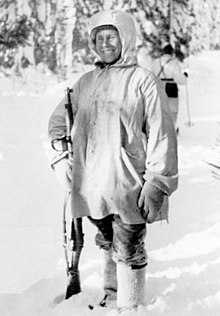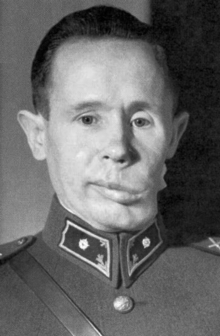Simo Häyhä: Difference between revisions
| Line 27: | Line 27: | ||
During the [[Winter War]] (1939–1940), between Finland and the Soviet Union, he began his duty as a [[sniper]] and fought for the [[Finnish Army]] against the Red Army in the 6th Company of JR 34 on the [[Kollaa River]]. In temperatures between −40 and −20 degrees Celsius, dressed completely in white [[Military camouflage|camouflage]], Häyhä was credited with 505 confirmed kills of Soviet soldiers.<ref name="Telegraph"/><ref name="MTV3">{{cite web |title=Sotasankarit-äänestyksen voitti tarkka-ampuja Simo Häyhä |work=[[MTV3]] |url=http://www.mtv3.fi/uutiset/arkisto.shtml/arkistot/kotimaa/2007/11/584680 |accessdate=30 March 2009 |language=Finnish}}</ref> A daily account of the kills at Kollaa was conducted for the Finnish snipers. Remarkably, all of Häyhä's kills were accomplished in fewer than 100 days{{spaced ndash}}in other words, an average of 5 kills per day{{spaced ndash}}at a time of year with very short hours of daylight.<ref>[http://books.google.com/books?id=p58vtOKyVy8C ''Finland at War 1939–45''], pp. 44–45. Brent Snodgrass, Raffaele Ruggeri. Osprey Publishing. ISBN 978-1-84176-969-1 (2006)</ref><ref>[http://books.google.com/books?id=-mkh931pIugC ''Out of Nowhere: A History of the Military Sniper''], p. 167. Martin Pegler. Osprey Publishing. ISBN 978-1-84603-140-3 (2006)</ref><ref>[http://books.google.com/books?id=l1a-kB-1MMAC ''Sniping: An Illustrated History''], pp. 117–118. Pat Farey, Mark Spicer. MBI Publishing Company. ISBN 978-0-7603-3717-2 (2009)</ref> |
During the [[Winter War]] (1939–1940), between Finland and the Soviet Union, he began his duty as a [[sniper]] and fought for the [[Finnish Army]] against the Red Army in the 6th Company of JR 34 on the [[Kollaa River]]. In temperatures between −40 and −20 degrees Celsius, dressed completely in white [[Military camouflage|camouflage]], Häyhä was credited with 505 confirmed kills of Soviet soldiers.<ref name="Telegraph"/><ref name="MTV3">{{cite web |title=Sotasankarit-äänestyksen voitti tarkka-ampuja Simo Häyhä |work=[[MTV3]] |url=http://www.mtv3.fi/uutiset/arkisto.shtml/arkistot/kotimaa/2007/11/584680 |accessdate=30 March 2009 |language=Finnish}}</ref> A daily account of the kills at Kollaa was conducted for the Finnish snipers. Remarkably, all of Häyhä's kills were accomplished in fewer than 100 days{{spaced ndash}}in other words, an average of 5 kills per day{{spaced ndash}}at a time of year with very short hours of daylight.<ref>[http://books.google.com/books?id=p58vtOKyVy8C ''Finland at War 1939–45''], pp. 44–45. Brent Snodgrass, Raffaele Ruggeri. Osprey Publishing. ISBN 978-1-84176-969-1 (2006)</ref><ref>[http://books.google.com/books?id=-mkh931pIugC ''Out of Nowhere: A History of the Military Sniper''], p. 167. Martin Pegler. Osprey Publishing. ISBN 978-1-84603-140-3 (2006)</ref><ref>[http://books.google.com/books?id=l1a-kB-1MMAC ''Sniping: An Illustrated History''], pp. 117–118. Pat Farey, Mark Spicer. MBI Publishing Company. ISBN 978-0-7603-3717-2 (2009)</ref> |
||
Häyhä used a Finnish militia variant of the Russian-made Mosin-Nagant rifle, the [[White Guard (Finland)|White Guard]] [[Mosin-Nagant#Finland|M28-30 "Pystykorva"]] (literally [[Spitz]], due to the sight's resemblance), because it suited his small frame (5 ft 3 in/1.60 m). He preferred to use [[iron sight]]s rather than [[telescopic sight]]s to present a smaller target (the sniper must raise his head higher when using a telescopic sight), for reliability (a telescopic sight's glass can fog up easily in cold weather) and for aid in concealment (sunlight glare in telescopic sight lenses can reveal a sniper's position). This model was used by [[Simo Häyhä]], a well-known [[Finnish people|Finnish]] sniper. Hes rifle was M28-30, serial number 60974. M28-30 was used as Civil Guards competition rifle before WWII, as was case with Simo Häyhä personal rifle too. |
Häyhä used a Finnish militia variant of the Russian-made Mosin-Nagant rifle, the [[White Guard (Finland)|White Guard]] [[Mosin-Nagant#Finland|M28-30 "Pystykorva"]] (literally [[Spitz]], due to the sight's resemblance), because it suited his small frame (5 ft 3 in/1.60 m). He preferred to use [[iron sight]]s rather than [[telescopic sight]]s to present a smaller target (the sniper must raise his head higher when using a telescopic sight), for reliability (a telescopic sight's glass can fog up easily in cold weather) and for aid in concealment (sunlight glare in telescopic sight lenses can reveal a sniper's position). This model was used by [[Simo Häyhä]], a well-known [[Finnish people|Finnish]] sniper. Hes rifle was M28-30, serial number 60974. M28-30 was used as Civil Guards competition rifle before WWII, as was case with Simo Häyhä´s personal rifle too. Rifles were built very well, with highest grade barrels available and carefully matched headspaces. Häyhä´s rifle was at PKarPr (Northern Carelia Brigade) museum in 2002, then moved to unknown place by Finnish Army. |
||
The Soviets tried several ploys to get rid of him, including [[Counter-sniper tactics|counter-snipers]] and [[artillery]] strikes. On March 6, 1940, Häyhä was shot in the lower left jaw by a Russian soldier during combat. The bullet tumbled upon impact and exited his head. He was picked up by fellow soldiers who said "half his head was missing", but he was not dead: he regained consciousness on March 13, the day [[Moscow Peace Treaty|peace was declared]]. Shortly after the war, Häyhä was promoted from [[Alikersantti|Alikersantti (Corporal)]] to [[Vänrikki|Vänrikki (Second Lieutenant)]] by [[Field Marshal]] [[Carl Gustaf Emil Mannerheim]]. No one else has gained rank so quickly in [[Military history of Finland|Finland's military history]]. |
The Soviets tried several ploys to get rid of him, including [[Counter-sniper tactics|counter-snipers]] and [[artillery]] strikes. On March 6, 1940, Häyhä was shot in the lower left jaw by a Russian soldier during combat. The bullet tumbled upon impact and exited his head. He was picked up by fellow soldiers who said "half his head was missing", but he was not dead: he regained consciousness on March 13, the day [[Moscow Peace Treaty|peace was declared]]. Shortly after the war, Häyhä was promoted from [[Alikersantti|Alikersantti (Corporal)]] to [[Vänrikki|Vänrikki (Second Lieutenant)]] by [[Field Marshal]] [[Carl Gustaf Emil Mannerheim]]. No one else has gained rank so quickly in [[Military history of Finland|Finland's military history]]. |
||
Revision as of 13:34, 1 October 2012
Simo Häyhä | |
|---|---|
 Häyhä after being awarded the honorary rifle model 28. | |
| Nickname(s) | White Death |
| Born | December 17, 1905 Rautjärvi, Finland |
| Died | April 1, 2002 (aged 96) Hamina, Finland |
| Allegiance | |
| Years of service | 1925–1940 |
| Rank | Alikersantti (Corporal) during the Winter War, promoted to Vänrikki (Second Lieutenant) shortly afterward[1] |
| Unit | Infantry Regiment 34 |
| Battles/wars | Winter War |
| Awards | Cross of Liberty, 3rd class and 4th class; Medal of Liberty, 1st class and 2nd class; Cross of Kollaa Battle[1] |
Simo Häyhä (Finnish pronunciation: [ˈsimɔ ˈhæy̯hæ]; December 17, 1905 – April 1, 2002), nicknamed "White Death" (Russian: Белая смерть, Belaya Smert; Finnish: valkoinen kuolema; Swedish: den vita döden) by the Red Army, was a Finnish sniper. Using a modified Mosin–Nagant in the Winter War, he has the highest recorded number of confirmed sniper kills – 505 – in any major war.[2]
Early life
Häyhä was born in the municipality of Rautjärvi near the present-day border of Finland and Russia, and started his military service in 1925. Before entering combat, Häyhä was a farmer and a hunter. At the age of 20, he joined the Finnish militia suojeluskunta and succeeded with his sniping skills in shooting sports in the Viipuri province. His farmhouse was reportedly full of trophies for marksmanship.[3]
Winter War service
During the Winter War (1939–1940), between Finland and the Soviet Union, he began his duty as a sniper and fought for the Finnish Army against the Red Army in the 6th Company of JR 34 on the Kollaa River. In temperatures between −40 and −20 degrees Celsius, dressed completely in white camouflage, Häyhä was credited with 505 confirmed kills of Soviet soldiers.[2][4] A daily account of the kills at Kollaa was conducted for the Finnish snipers. Remarkably, all of Häyhä's kills were accomplished in fewer than 100 days – in other words, an average of 5 kills per day – at a time of year with very short hours of daylight.[5][6][7]
Häyhä used a Finnish militia variant of the Russian-made Mosin-Nagant rifle, the White Guard M28-30 "Pystykorva" (literally Spitz, due to the sight's resemblance), because it suited his small frame (5 ft 3 in/1.60 m). He preferred to use iron sights rather than telescopic sights to present a smaller target (the sniper must raise his head higher when using a telescopic sight), for reliability (a telescopic sight's glass can fog up easily in cold weather) and for aid in concealment (sunlight glare in telescopic sight lenses can reveal a sniper's position). This model was used by Simo Häyhä, a well-known Finnish sniper. Hes rifle was M28-30, serial number 60974. M28-30 was used as Civil Guards competition rifle before WWII, as was case with Simo Häyhä´s personal rifle too. Rifles were built very well, with highest grade barrels available and carefully matched headspaces. Häyhä´s rifle was at PKarPr (Northern Carelia Brigade) museum in 2002, then moved to unknown place by Finnish Army.
The Soviets tried several ploys to get rid of him, including counter-snipers and artillery strikes. On March 6, 1940, Häyhä was shot in the lower left jaw by a Russian soldier during combat. The bullet tumbled upon impact and exited his head. He was picked up by fellow soldiers who said "half his head was missing", but he was not dead: he regained consciousness on March 13, the day peace was declared. Shortly after the war, Häyhä was promoted from Alikersantti (Corporal) to Vänrikki (Second Lieutenant) by Field Marshal Carl Gustaf Emil Mannerheim. No one else has gained rank so quickly in Finland's military history.
Later life

It took several years for Häyhä to recuperate from his wound. The bullet had crushed his jaw and blown off his left cheek. Nonetheless, he made a full recovery and became a successful moose hunter and dog breeder after World War II, and hunted with Finnish president Urho Kekkonen.
When asked in 1998 how he had become such a good shooter, he answered "Practice." When asked if he regretted killing so many people, he said "I only did my duty, and what I was told to do, as well as I could." Simo Häyhä spent his last years in Ruokolahti, a small municipality located in southeastern Finland, near the Russian border.
Film
Actor Steven Wiig portrayed Häyhä in the 2012 HBO docudrama Hemingway & Gellhorn.
References
- ^ a b Lappalainen, Jukka-Pekka (6 December 2001). "Kollaa kesti, niin myös Simo Häyhä" (fee required). Helsingin Sanomat (in Finnish). Helsinki. Retrieved 19 February 2011.
{{cite news}}: Unknown parameter|trans_title=ignored (|trans-title=suggested) (help) - ^ a b Rayment, Sean (30 April 2006). "The long view". The Daily Telegraph. London. Retrieved 30 March 2009.
- ^ Gilbert, Adrian (1996). Sniper: The Skills, the Weapons, and the Experiences. St. Martin's Press. p. 88. ISBN 0-312-95766-1.
- ^ "Sotasankarit-äänestyksen voitti tarkka-ampuja Simo Häyhä". MTV3 (in Finnish). Retrieved 30 March 2009.
- ^ Finland at War 1939–45, pp. 44–45. Brent Snodgrass, Raffaele Ruggeri. Osprey Publishing. ISBN 978-1-84176-969-1 (2006)
- ^ Out of Nowhere: A History of the Military Sniper, p. 167. Martin Pegler. Osprey Publishing. ISBN 978-1-84603-140-3 (2006)
- ^ Sniping: An Illustrated History, pp. 117–118. Pat Farey, Mark Spicer. MBI Publishing Company. ISBN 978-0-7603-3717-2 (2009)
Further reading
- P. Sarjanen, Valkoinen kuolema ISBN 952-5170-05-5
- Tapio A. M. Saarelainen, Sankarikorpraali Simo Häyhä ISBN 952-5026-52-3 http://www.apali.fi
- Tapio A. M. Saarelainen, The Sniper – Simo Häyhä ISBN 978-952-5026-74-0 http://www.apali.fi
External links
- Brief background on Simo Häyhä
- Mosin-Nagant Dot Net's Sniper Section Presents "Meeting A Legend: Simo Häyhä"
- 1905 births
- 2002 deaths
- People from Rautjärvi
- Finnish military personnel of World War II
- Sniper warfare
- Recipients of the Order of the Cross of Liberty, 3rd Class
- Recipients of the Order of the Cross of Liberty, 4th Class
- Recipients of the Order of the Cross of Liberty, Medal of Liberty 1st Class
- Recipients of the Order of the Cross of Liberty, Medal of Liberty 2nd Class
